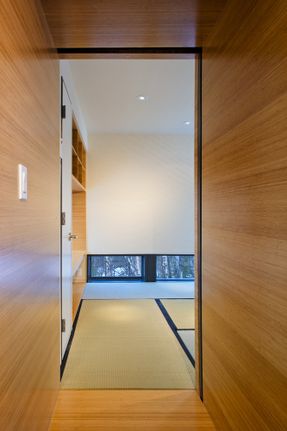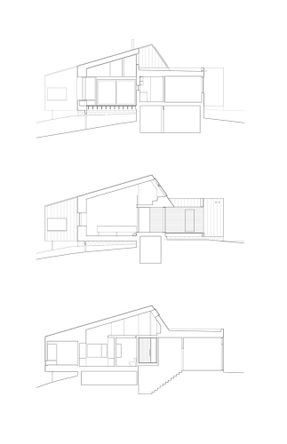Nearpoint Residence
LOCATION
Anchorage, AK, USA
PROJECT YEAR
2009
AREA
2900.0 ft2
Text description provided by architect.
DESIGN AND PERFORMANCE
The design was informed by four primary considerations:
To form strong visual and spatial ties to landscape and daylight. To limit use of resources through compactness, energy efficiency, and durability.
To create relationships between lifestyle, environment, and thermal performance. To optimize exterior envelope, aperture, and building systems requirements.
Stretched long the house creates a sequential and spatial response to the changing landscape character of the ridge. Beginning with the very near, ground-related forest understory, the spatial scale of the house expands as one moves out the ridge to engage the distant panorama before returning to the intimate adjacent landscape.
Ground intervention and site disruption are minimized by inserting the structure within an existing vegetative clearing and cantilevering the primary living areas off of a compact basement footprint.
Use Groups are configured to optimize program specificity, social function, landscape interaction, environmental relationships, and energy performance.
Collective spaces + stable long term inhabitation + big landscape connection
Individual spaces + intermittent inhabitation + near landscape connection
Private spaces + intermittent / night time inhabitation + limited landscape connection
This strategy drives the spatial and resultant formal configuration of the house, enabling high performance and environmental zone control between adjacent living areas.
Operability mediates issues of privacy, thermal performance, activity, sunlight, daylight, and climate at use group, building, and environment interface.
Specificity of exterior envelope, aperture, and building systems optimize interior environment conditions. Passive winter heating is achieved with a continuous south facing clerestory designed at an optimum slope and orientation for solar photovoltaic energy and solar hot water production. Radiant in-floor heating system with thermal mass concrete floors and ample natural ventilation regulate a temperate environment throughout the year.
Materials selected for performance. Standing-seam metal cladding wraps the building’s exterior walls and roof. Fireproof and durable, it provides a protective shell.
Within this shell, softer woods of fir and cedar, like a fleece pullover, wrap the surfaces of human contact. Finished in either white or ebony semi-transparent stains, these soft woods seek to be both abstract and materially expressive. Bamboo casework and blackened steel accents compliment the environmentally honest palate.
Unique Properties Of The North
Big sliding doors
The house is transformable. It is organized into different types of spaces that require similar thermal performance, social function, and landscape/environment relationships.
These smaller "use groups" allow for high performing environmental control. To optimize the thermal performance, big sliding doors allow each thermal use group to be either connected or isolated from the others.
A WINTER HOUSE
On the exterior, cool gray metal siding with a warm white wood. This is a considered material palette for the snowy long winters.
On the interior, warm rich woods as surfaces of contact.
Selected materials with textures that catch the low sun angles.
SEASONAL CHANGE | DAILY CHANGE
The planning of the house recognizes the temporal aspects of inhabitation and provides a variety of idealized spaces that respond to the extreme seasonal change of the North, as well as the daily change of family life. Primarily, the south deck and the western living space with the adjacent covered deck seek to bridge these swings by providing for distinctly winter/daytime spaces as well as summer/evening spaces, respectively.
SUN AND VIEW….POLAR OPPOSITES
Views are primarily to the north, the sun to the south.
The design lifts the roof of the collective spaces to create a south facing clerestory. This design move provides year round sunlight into the main living space and a skyview of Near Point, a local mountain ridge just above the house. Roof slope is aligned for optimal solar exposure and photovoltaic and solar hot water panel arrays.
SHELTER
As an intense environment, the north, at times, commands inner thought, reflection, and calmness. Coupled with the clients demanding professional responsibilities and active lifestyle a variety of spaces needed to respond accordingly.
With large social functions and everyday use the public realm of the house lives big. Refuge and security can be found in adjacent closed spaces, such as the tatami room, a very specific meditative space with strong ties to the landscape.



















